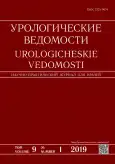Ways to optimize the assessment of lean body mass in hemodialysis patients
- Authors: Lavrishcheva J.V.1, Jakovenko A.A.2
-
Affiliations:
- Almazov National Medical Research Centre of the Ministry of Healthcare of the Russian Federation
- Pavlov First Saint Petersburg State Medical University
- Issue: Vol 9, No 1 (2019)
- Pages: 23-28
- Section: Original articles
- URL: https://journals.rcsi.science/uroved/article/view/11330
- DOI: https://doi.org/10.17816/uroved9123-28
- ID: 11330
Cite item
Full Text
Abstract
The aim. To conduct a comparative analysis of the effectiveness of methods for assessing lean body mass in haemodialysis patients.
Patients and methods. A total of 317 patients receiving treatment with programmatic bicarbonate haemodialysis in 9 haemodialysis centers in 5 regions of the European part of the Russian Federation were examined for 8.2 ± 5.1 years, among them 171 women and 146 men, the average age was 57.1 ± 11.3 years. Dual-energy X-ray absorptiometry and bioimpedancemetry were used to assess lean body mass.
Results. The results of determining the total lean body mass obtained from the results of dual-energy X-ray absorptiometry and bioimpedancemetry were compared using the Bland-Altman method. The correlation coefficient between the indicators was r = 0.994, p < 0.0001, delta (M ± σ) was –0.48 ± 0.91 kg, CI 95% (–0.71)–(–0.26) kg.
Conclusion. Dual-energy X-ray absorptiometry has no significant advantages compared with bioimpedancemetry when evaluating lean body mass in haemodialysis patients.
Full Text
##article.viewOnOriginalSite##About the authors
Juliia V. Lavrishcheva
Almazov National Medical Research Centre of the Ministry of Healthcare of the Russian Federation
Author for correspondence.
Email: lavrischeva@gmail.com
Nephrologist
Russian Federation, Saint PetersburgAleksandr A. Jakovenko
Pavlov First Saint Petersburg State Medical University
Email: leptin-rulit@mail.ru
Candidate of Medical Science, Associate Professor
Russian Federation, Saint PetersburgReferences
- Kittiskulnam P, Chertow GM, Carrero JJ, et al. Sarcopenia and its individual criteria are associated, in part, with mortality among patients on hemodialysis. Kidney Int. 2017;92(1):238-247. https://doi.org/10.1016/j.kint.2017.01.024.
- Giglio J, Kamimura MA, Lamarca F, et al. Association of Sarcopenia with Nutritional Parameters, Quality of Life, Hospitalization, and Mortality Rates of Elderly Patients on Hemodialysis. J Ren Nutr. 2018;28(3):197-207. https://doi.org/10.1053/j.jrn.2017.12.003.
- Bataille S, Serveaux M, Carreno E, et al. The diagnosis of sarcopenia is mainly driven by muscle mass in hemodialysis patients. Clin Nutr. 2017;36(6):1654-1660. https://doi.org/10.1016/j.clnu.2016.10.016.
- Messina C, Maffi G, Vitale JA, et al. Diagnostic imaging of osteoporosis and sarcopenia: a narrative review. Quant Imaging Med Surg. 2018;8(1):86-99. https://doi.org/10.21037/qims.2018.01.01.
- Battaglia Y, Galeano D, Cojocaru E, et al. Muscle-wasting in end stage renal disease in dialysis treatment: a review. G Ital Nefrol. 2016;33(2).
- Cruz-Jentoft AJ, Baeyens JP, Bauer JM, et al. Sarcopenia: European consensus on definition and diagnosis: Report of the European Working Group on Sarcopenia in Older People. Age Ageing. 2010;39(4):412-423. https://doi.org/10.1093/ageing/afq034.
- Arias-Guillen M, Perez E, Herrera P, et al. Bioimpedance spectroscopy as a practical tool for the early detection and prevention of protein-energy wasting in hemodialysis patients. J Ren Nutr. 2018;28(5):324-332. https://doi.org/10.1053/j.jrn.2018.02.004.
- Guglielmi G, Ponti F, Agostini M, et al. The role of DXA in sarcopenia. Aging Clin Exp Res. 2016;28(6):1047-1060. https://doi.org/10.1007/s40520-016-0589-3.
- Popovic V, Zerahn B, Heaf JG. Comparison of dual energy X-ray absorptiometry and bioimpedance in assessing body composition and nutrition in peritoneal dialysis patients. J Ren Nutr. 2017;27(5):355-363. https://doi.org/10.1053/j.jrn.2017.03.003.
- Kittiskulnam P, Carrero JJ, Chertow GM, et al. Sarcopenia among patients receiving hemodialysis: weighing the evidence. J Cachexia Sarcopenia Muscle. 2017;8(1):57-68. https://doi.org/10.1002/jcsm.12130.
- Dehesa-Lopez E, Correa-Rotter R, Olvera-Castillo D, et al. Transcultural adaptation and validation of the Mexican version of the kidney disease questionnaire KDQOL-SF36 version 1.3. Qual Life Res. 2017;26(1):193-198. https://doi.org/10.1007/s11136-016-1365-8.
- Cao L, Morley JE. Sarcopenia is recognized as an independent condition by an international classification of disease, tenth revision, clinical modification (ICD-10-CM) Code. J Am Med Dir Assoc. 2016;17(8):675-677. https://doi.org/10.1016/j.jamda.2016.06.001.
Supplementary files








